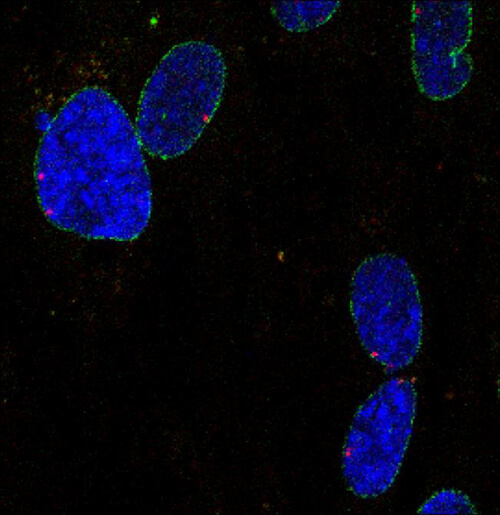



Business Inquiry
Global:
Email:marketing@medicilon.com
+1(781)535-1428(U.S.)
0044 7790 816 954 (Europe)
China:
Email: marketing@medicilon.com.cn
Tel: +86 (21) 5859-1500



Best known as transport gateways for shuttling material into and out of the nucleus, nuclear pores have also been shown to control genomic functions such as transcription, chromosome duplication, and segregation. And these regulatory functions, uncovered last year by Salk Institute scientists, hardly exhaust nuclear pores’ capabilities. According to a new study by the same Salk Institute scientists, nuclear pores may influence gene expression by interacting with genomic regions called superenhancers (SEs). These regions are known to help determine cell identity.

“Our research shows that, far from being a passive enclosure as many biologists have thought, the nuclear membrane is an active regulatory structure,” said Martin Hetzer, Ph.D., professor in the Molecular and Cell Biology Laboratory at the Salk Institute for Biological Studies. “Not only does it interact with portions of the genome to drive gene expression, but it can also contribute to disease processes when components are faulty.”
Dr. Hetzer is the senior author of a paper (“Nucleoporin-Mediated Regulation of Cell Identity Genes”) that appeared November 2 in the journal Genes & Development. This paper describes how Dr. Hetzer’s team used a suite of molecular biology technologies to discover that two nuclear pore proteins actively associate with stretches of DNA to trigger expression of key genes.
“Here, we show that nuclear pore complex (NPC) components Nup93 and Nup153 bind superenhancers (SEs), regulatory structures that drive the expression of key genes that specify cell identity,” wrote the article’s authors. “We found that nucleoporin-associated SEs localize preferentially to the nuclear periphery, and absence of Nup153 and Nup93 results in dramatic transcriptional changes of SE-associated genes.”
The article reinforces the idea that nuclear pore complexes are not just gateways between the cytosol and the nucleus, but are also structures that have higher-level regulatory functions. Better understanding these higher-level functions could provide insight into diseases that appear to be related to dysfunctional nuclear membrane components, such as leukemia, heart disease, and aging disorders.
To investigate the regions of DNA with which nucleoporins potentially interact, Dr. Hetzer’s team turned to a human bone cancer cell line. The scientists used a molecular biology technique called DamID, or DNA adenine methyltransferase identification, to pinpoint where Nup153 and Nup93 may contact with the genome. Then the scientists used several other sequencing techniques to understand which genes were being affected in those regions, and how.
It was at this point that the researchers discovered that Nup153 and Nup93 may interact with SEs. Since every cell in our body has the same DNA, what makes a muscle cell different from a liver cell or a nerve cell is which particular genes are turned on, or expressed, within that cell. In the Salk study, the presence of Nup153 and Nup93 was found to regulate expression of SE-driven genes, and experiments that silenced either protein resulted in abnormal gene expression from these regions.
Further experiments in a lung cancer cell line validated the bone cancer line results: Nucleoporins in the NPC were found to interact with multiple SE regions to drive gene expression, while experiments that altered the NPC proteins made related gene expression faulty, even though the proteins still performed their primary role as gatekeepers in the cell membrane.
“It was incredible to find that we could perturb the proteins without affecting their gateway role, but still have nearby gene expression go awry,” remarked Arkaitz Ibarra, Ph.D., a Salk staff scientist and first author of the paper.
“Our results,” the Genes & Development article concluded, “reveal a crucial role of NPC components in the regulation of cell type-specifying genes and highlight nuclear architecture as a regulatory layer of genome functions in cell fate.” The results reported in the article also bolster other work indicating that problems with the nuclear membrane play a role in heart disease, leukemia, and progeria, a rare premature aging syndrome.
“People have thought the nuclear membrane is just a protective barrier, which is maybe the reason why it evolved in the first place,” noted Dr. Hetzer. “But there are many more regulatory levels that we don’t understand. And it’s such an important area because so far, every membrane protein that has been studied and found to be mutated or mislocalized seems to cause a human disease.”
 Relevant
news
Relevant
news